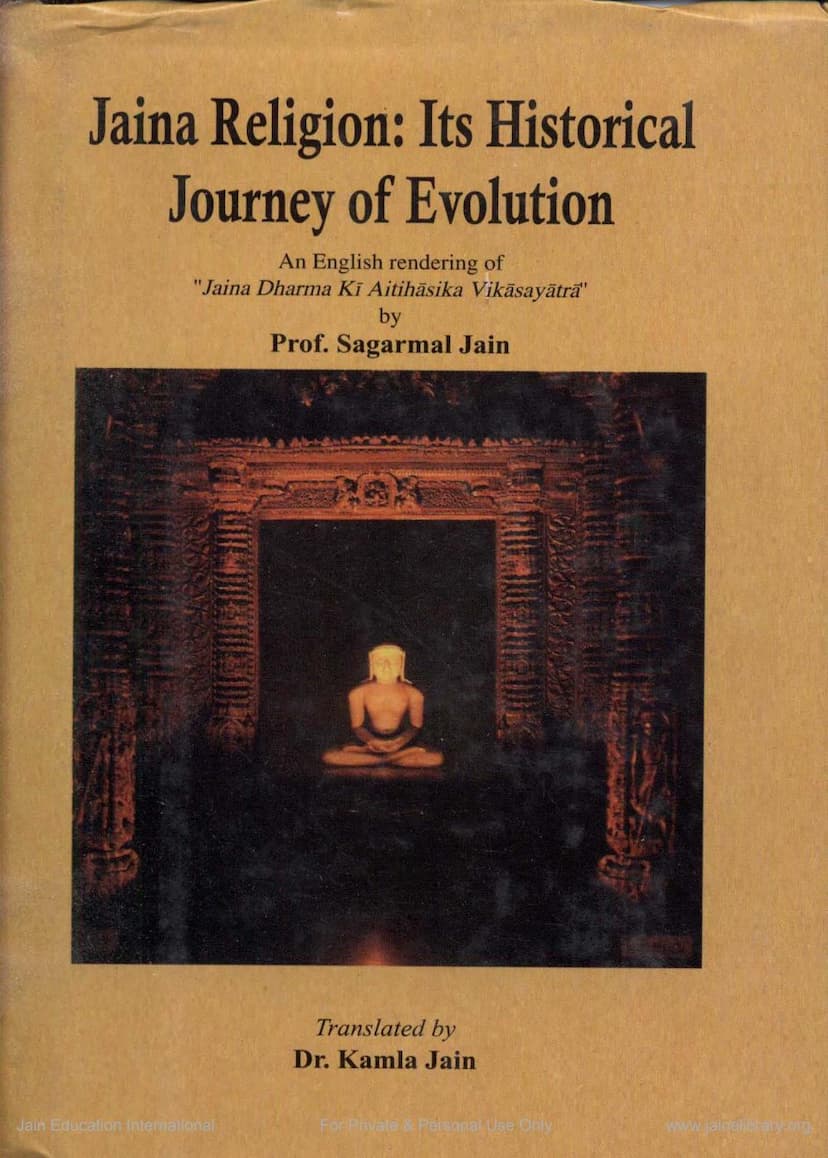Jaina Religion Historical Journey Of Evolution
Added to library: September 2, 2025

Summary
Here is a comprehensive summary of the provided Jain text, "Jaina Religion: Its Historical Journey of Evolution" by Sagarmal Jain, translated by Dr. Kamla Jain:
Overview:
This book, an English translation of "Jaina Dharma Ki Aitihāsika Vikāsayātrā," meticulously traces the historical evolution of the Jaina tradition from its ancient origins to the present day. The author, Prof. Sagarmal Jain, honestly examines the development of Jainism, acknowledging the influences of other contemporary religious traditions. The work delves into the historical background and causes behind the emergence of various Jaina sects and explores the "twists and turns" in the religion's evolutionary journey.
Key Themes and Arguments:
-
Jainism as a Dynamic, Evolving Tradition: The book emphasizes that Jainism, like any living faith, has not remained static. It has adapted and changed over time due to historical circumstances, geographical influences, and interactions with other traditions. The notion of Jainism being unaltered since its inception is presented as an illusion.
-
The Śramana Tradition: Jainism is firmly placed within the broader ancient Śramana (or Ārhat) tradition, characterized by its focus on nivṛtti (renunciation), highlighting the inherent suffering of worldly existence, and advocating for spiritual endeavors, moral values (śīla, vrata), and the ultimate goal of moksha (liberation). This tradition also includes Buddhism, Upanishadic thought, Sāmkhya-Yoga, and now-lost streams like the Ajivikas.
-
Vedic vs. Śramana Dharmas: The text contrasts the Pravṛtti (action)-centered Vedic/Hindu tradition with the Nivrtti (renunciation)-centered Śramana tradition.
- Pravṛtti Dharma: Focuses on worldly enjoyment (preya), action (karma-mārga), faith-based devotion (bhakti-mārga), worship of external powers, and aims for heaven (svarga). It generally accepted the caste system.
- Nivrtti Dharma: Focuses on spiritual values (śreya), self-control, detachment, renunciation, and aims for moksha. It emphasizes individual effort (puruṣārtha), karma theory, and the primacy of the soul over the body. It generally opposed the caste system.
-
Mutual Influence and Synthesis: A central argument is that the Vedic and Śramana streams, despite their differing origins, have been in constant dialogue and mutual influence throughout Indian history.
- Vedic Stream's Absorption of Śramana Elements: Hinduism absorbed concepts like renunciation, meditation, and liberation from the Śramana tradition, particularly evident in the Upanishads and the Bhagavad Gita, which represent a synthesis.
- Śramana Stream's Absorption of Vedic Elements: Jainism and Buddhism, in turn, adopted elements from the Vedic tradition, including rituals, worship styles, and the incorporation of various Hindu deities (e.g., Yakshas, Yakshinis becoming caretaker deities like Ambika, Padmavati). This led to a blend of pravṛtti and nivṛtti in practice.
-
The Ancient Roots of Jainism: Evidence from Harappa and Mohenjo-daro, as well as the Rigveda, suggests the existence of Śramana culture and figures like Arhats, Vrātyas, and Munis, indicating that the Ārhat or Śramana tradition predates the current terminology of "Jaina Dharma." The terms "Nirgrantha" and "Arhat" were used historically to refer to this tradition.
-
The Nirgrantha Tradition: The text traces the history of the Nirgrantha tradition, identifying Pārśvanātha and Mahāvīra as key figures. It discusses the initial separation and eventual (though not complete) merger of their followers. The historical evidence for the middle twenty-two Tirthankaras is acknowledged as being primarily based on Āgamas and narratives.
-
Mahāvīra and Contemporary Traditions: The book highlights Mahāvīra's relationship with other contemporary thinkers and traditions, particularly the Ājivakas (led by Makkhali Gośāla), and explores the potential influences between them. It also touches upon the early divisions within the Nirgrantha Sangha, such as the divergence with Jamāli.
-
Spread of Jainism: The geographical spread of the Nirgrantha Sangha is discussed, detailing its movement from Bihar to South India and Southeast Asia, and the eventual re-establishment of its presence in India. The influence of climate and local customs on practices like nudity is explored.
-
Internal Divisions and Developments: The text examines the historical development of the Digambara and Śvetāmbara traditions, the emergence of various ganas and sub-sects, and the debates surrounding ascetic practices like the use of clothing and begging bowls. The role of figures like Ācārya Bhadrabāhu and Sthūlibhadra is noted.
-
The Impact of Vedic Ritualism and Bhakti: The book critically analyzes how the Jaina tradition, originally opposed to many Vedic rituals, gradually incorporated elements of temple building, idol worship, and elaborate rituals (like the eightfold worship and later seventeen-fold worship) due to the pervasive influence of Hindu traditions and the larger socio-cultural milieu. This also led to the introduction of caretaker deities (Yakshas, Yakshinis) to fulfill the worldly desires of devotees, a concept alien to the original Jaina philosophy of Tirthankaras.
-
Reformation Movements: The text discusses significant reform movements within Jainism, spurred by the laxity in monastic conduct and the overwhelming influence of rituals. The iconoclastic stance of Muslim rulers and the simplicity of Islamic worship also played a role in inspiring movements like Lokāśāha, Sthānakavāsī, and Terāpantha, which emphasized spiritual essence over ritualistic fanfare and, in some cases, rejected idol worship altogether.
-
Jaina Contributions to Art and Literature: Despite periods of perceived laxity, the book highlights the substantial and significant contributions of Jainas to art and literature during the medieval period, citing examples like Khajuraho, Shravanabelgola, and the Dilwara temples. Competent Ācāryas produced important philosophical and literary works.
-
Emphasis on Spiritual Purity: Throughout its history, and especially in the reform movements, there has been a recurring emphasis on the spiritual purification of the individual, the primacy of thought over ritual, and the core spiritual tenets of Jainism, even as external practices evolved.
Conclusion:
Prof. Sagarmal Jain's work offers a nuanced and comprehensive historical analysis of Jaina religion, emphasizing its dynamic nature and its intricate relationship with the broader cultural and religious landscape of India. It argues for a holistic understanding of Indian religions, recognizing the interconnectedness and mutual influences that have shaped their evolution. The book is intended for both general readers interested in Jainism and scholars of religious history.